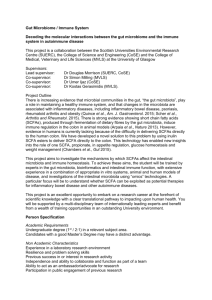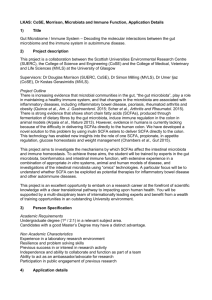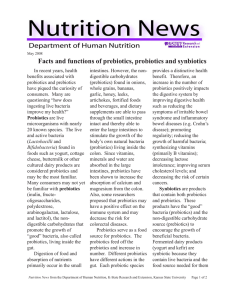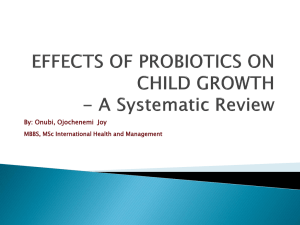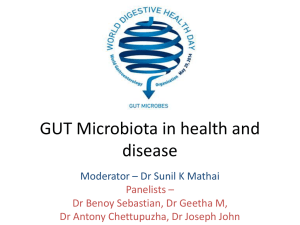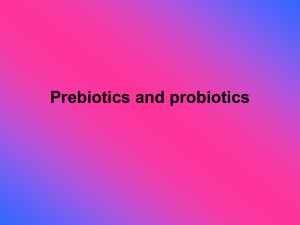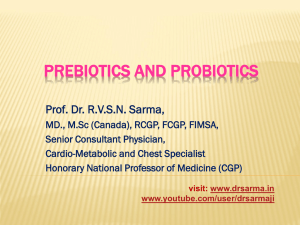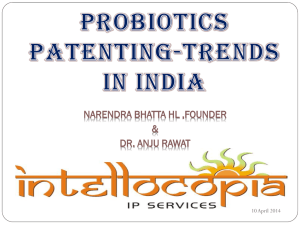last prebiotics 19.5.2011
advertisement
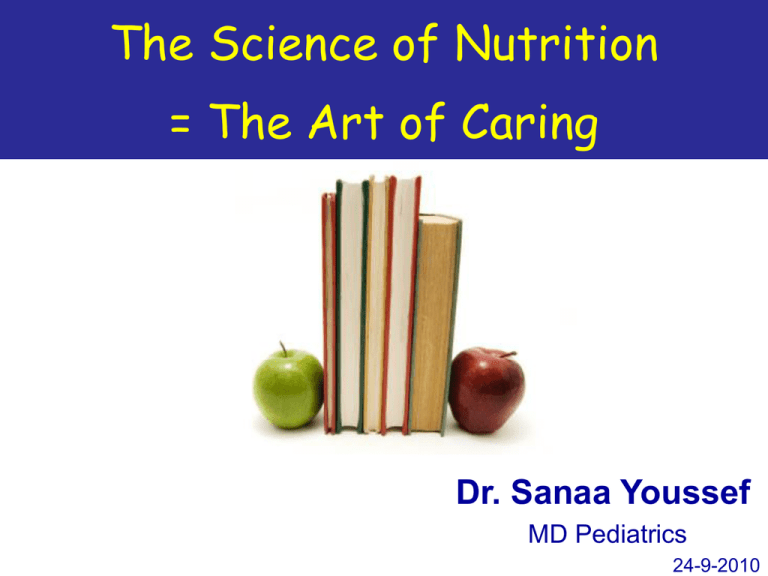
The Science of Nutrition = The Art of Caring Dr. Sanaa Youssef MD Pediatrics 24-9-2010 Goals of This Talk Understanding Updates about the Rediscovery of the Human GIT Highlighting the importance and function New Emerging Ingredients (PRObiotics – PREbiotics) My audience will STILL be AWAKE by the end of the talk. The Rediscovery of the INNER TUBE OF LIFE the Human GIT INNER TUBE OF LIFE The intestine is an extremely complex system that participates in protection of the host through strong defense mechanisms from the external environment; Defense task is based on three compartments that are in permanent contact and dialogue with each other: 1- The ecological barrier (normal inhabitant flora within intestine) 2- Mechanical barrier (mucous epithelia) 3- Immune barrier (GALT, secretory IgA, intraepithelial lymphocytes, macrophages, neutrophils, natural killer cells, Payer’s nodes and mesenteric lymph node) (Mohajer, 2000) Our Intestine = 400 square meter surface… i.e. the surface area of a tennis court INNER TUBE OF LIFE Historical Facts The colon Is a part of the body's digestive system (about six feet long) that moves waste material from the small intestine to the rectum. Little was known about colonic functions. Many thought that the colon was a colander that strained the feces. Later Accepted ROLES about colonic functions : Conservation of water and electrolytes Control evacuation of faeces INNER TUBE OF LIFE Advances in understanding Colonic function Recent researches demonstrated the importance of the colon as a metabolic organ with an influence on overall metabolism, an effect that is attributed to activity of Microflora the role of which was Underestimated. New studies revealed: The role played by microbiota in the colon. Functions of different mucosal epithelial cells of the colon.(Immunocompetent cells) The mucosal hydrophobicity of the colon.(A 2000;46:515-521 doi:10.1136/gut.46.4.515 ) Lugea et al,Gut Did you know that in the “COLON World”….!!!?? Battles are Fought, Helpful Substances are Manufactured, & The immune system is Bolstered. Where “Man Meets Microbe” A Dynamic Interplay Trillions living bacteria exist in the human intestine We have more bacteria in our bodies (10 times greater) than the total number of our somatic and germ cells We carry about 2 kg of bacteria !!!!!!!! Over 500 species of bacteria present in human colon. Lactobacillus Bifidis and Acidophilus comprise the majority of healthy bacteria in the colon along with other disease producing bacteria. Where “Man Meets Microbe” A Dynamic Interplay 1- Short Transient Time 2- Bile milieu 3- Pancreatic secretion 4- ph = 7 (neutral) HCL Mucous, cells….. Prevents bacterial reflux Ileo-ceocal valve Where “Man Meets Microbe” A Dynamic Interplay Our gut Microbiota can be pictured as a MICROBIAL ORGAN placed within a host organ “The intestine is not only a digestive absorptive organ but it is the largest immune organ in our body.” The very rapidly developing immune system begins from birth up to 2 years. It starts with creating a healthy digestive system which plays a major role from infancy and throughout all our life (about 80% of our immune system is found in the GIT) “ This immature immune system needs special measures for its Protection and Support.” Sharing My Secrets of Health Early In Life ??? The gastrointestinal tract of a normal fetus is sterile. During the birth process: the aseptic or sterile, digestive tract of the fetus is inoculated with bacteria (proximity of the birth canal and the anus). Rapidly thereafter, effective methods of ensuring transmission of microbes to the sterile GIT: o parental expression of neonatal care: suckling, kissing and caressing (mother’s flora) o Genetic factor o surrounding environment o Feeding pattern: the first biggest challenge is one the intestine becomes inhabited by microbes which are characterized by instability and fragility. Later the microbiota will stabilize according to the type of feeding. Early In Life ??? The first colonization of the intestine is one of the most profound immunological exposures faced by the newborn infant (during the first days of life). The next great changes in the composition of the intestinal microbiota come with the introduction of solid food and weaning (Favier et al., 2002). Hygiene Hypothesis: Decreased bacterial stimulation during infancy and childhood is asscociated with slower postnatal development and delayed maturation of the immune system. (L.E.M. Niers et al., 2005) Relatively small changes will take place by after years of age where the child will have an adult-like microbiota and then it remains practically unchanged (Zoetendal et al., 2008). New Perspective In INFANT NUTRITION New emerging dietary ingredients Probiotics and Prebiotics share a unique role in human nutrition. Research has shown that Probiotics and Prebiotics are useful in achieving positive health effects and well being to the host. PRObiotics “LIVE” microorganisms which confer health benefits on the host”, when administered in adequate amounts. (Marco ML et al,2006) Probiotic is not a synonym for native beneficial bacteria, although they may be isolated from this source. They should be identified by genus, species and when appropriate by strain when supplemented. The term “probiotic,” by definition, can never be used to describe products comprised primarily of Dead Bacteria. (Journal of the American Dietetic Assosciatio,2008) PRObiotics Probiotics are sensitive in a strain-dependent manner to environmental exposures such as heat, moisture, oxygen, and acid. Once the package is opened, these barriers are compromised. The doses should reflect any losses inherent to the probiotic as it moves through the alimentary canal. When wishing to deliver their benefits (Immune enhancement) dose should be adjusted according to the strain and better increased level of the Probiotic should be considered because of the losses. (Journal of the American Dietetic Assosciatio,2008) PRObiotics • They Only Transiently colonize the Gut and do not typically become part of the permanent resident micro flora of the host. NO Statement should generally refer to Probiotics as “Efficacious or Safe”; this would be as inappropriate as stating Antibiotics in general are “Efficacious and Safe”. (Journal of the American Dietetic Assosciatio,2008) PREbiotics The term prebiotic was introduced by Gibson and Roberfroid 1995 who exchanged “PRO" for “PRE" which means “Before“. ‘A prebiotic is a selectively fermented ingredient that allows specific changes, both in the composition and ⁄ or activity in the gastrointestinal microbiota that confers benefits upon host well-being and health.’(Gibson et al., 2004) “Nutriceuticals” or “Biotherapeutics” or “Prebiotics” = substances or supplements administered to obtain nutraceutical effects that extend “beyond those of regular nutrition.” (Journal of the American Dietetic Assosciatio,2008) Facts about PREbiotics Prebiotics; are simply speaking the preferential “FOOD” for Friendly Beneficial Bacteria colonizing the digestive tract. “colonic food” They are dietary supplements that play a role in Balancing the Intestinal Mucosal Immune System in newborns and children. Criteria for eligibility as PREbiotic (Gibson et al., 2007) 1) Resistance to gastric acidity, to hydrolysis by mammalian enzymes, and to gastrointestinal absorption; 2) Selective stimulation of the growth and/or activity of those intestinal bacteria that contribute to health and well-being 3) Fermentation by intestinal microflora; to produce SCFA & gas. 4) Induce LUMINAL or SYSTEMIC beneficial effects. Established PREbiotics Breast Milk oligosaccharides Original they represent the third largest component of Human Milk 20 - 23 gm/l in colostrum & 12- 14 gm/ in mature milk. Polydextrose – Fructans Inulin Wheat, banana, onions, garlic, leek, chicory. FOS (Fructo-oligosaccharides or oligofructose) plants. GOS (Galacto-oligosaccharides) milk. (also known as TOS – trans-galacto-oligosaccharides) Lactulose - Lactosucrose SOS (soy-oligosaccharides) XOS (xylo-oligosaccharides) IMO (isomalto-oligosaccharides) corn & wheat. Lactitol (Journal of the American Dietetic Assosciatio,2008) SyMbiosis SyMbiosis Symbiosis (Greek: syM "with"; & biosis "living") The term was first used in 1879 by the German mycologist Heinrich Anton de Bary, who defined it as "the living together of unlike organisms.“ Commensalism is a class of relationship between two organisms There are two associations: Mutualism: (facultative) both organisms benefit Parasitism: (obligate) one organism benefits and the other one is harmed. SyMbiosis “Intestinal Microbiota is an example of A symbiotic relationship with the host” Host-Bacteria interaction responsible for the effectiveness of gut immune related mechanisms. POSTbiotics POSTbiotics Short chain fatty acids (SCFAs) are the products of colonic bacterial degradation of unabsorbed starch and non-starch polysaccharide (fibre). The main acids: Acetate, Propionate, and Butyrate and Lactic acid. They are important anions in the colonic lumen, affecting both Colonocyte Morphology (Proliferation / Differentiation) & Function (Tight Colonic Junction / Inflammatory Suppression). SCFA support the critical Gut mucosal barrier: Keeping Gut integrity Butyrate is the preferred energy substrate for the colonocyte, it provides fuel (nutrition) for ileal and colonic epithelial cells, which help maintain the integrity of the colon. LOW Resistant Starch & Fiber Diet low SCFA production in colon explain the high occurrence of colonic disorders. Safe Alternative Therapeutic Strategy ??????? SCFA help improve Water & Electrolyte Absorption and Bowel Movement • SCFA facilitate the absorption of water and electrolytes that in turn helps minimizing the risk of diarrhea as well as its volume. • Acetate increases colonic blood flow and enhances ileal motility. • SCFA may be involved in the: Ileo - Colonic Brake” Stimulates contractions of the ileum and shortens ileal emptying. DYSBiosis DYSBiosis Dysbiosis is the abnormal microbial colonization of the intestine , where changes in Quantity and Quality of flora become Pathological & Harmful. When intestinal flora equilibrium is disturbed, the optimum expected health effects are lost autoimmune conditions result (IBD, rheumatoid). A common cause of dysbiosis is antibiotic therapy (Iatrogenic). Thank your for your patience References 1. 2. 3. 4. 5. 6. 7. 8. 9. 10. American Journal of Clinical Nutrition, Vol. 69, No. 5, 1035S – 1045S, May 1999. Gastroenterology and Nutrition in infancy (GNI). International Food Information Council (IFIC). International Food Information Foundation’s Media Guide on Food Safety and Nutrition. Nutrition Information Centre University of Stellenbosch (NICUS). HEALL: Health Education Alliance for Life and Longevity. Can J Gastroenterol. 2004 Mar;18(3):163-7 Redefining lactose as a conditional prebiotic. Daniells, Stephen, Prebiotics Could Reduce Artery Hardening, Boost Heart Health, NutraIngredients.com, 2 January 2007. Hamilton-Miller, JMT, Probiotics and Prebiotics in the Elderly, 20 January 2004. Marco ML et al; Towards understanding molecular modes of probiotic action. Curr Opin Biotechnol 2006; 17:204–210. References 11. Prebiotics Could Improve Heart Health, NPICenter.com, 22 December 2006. 12. Saavedra, J.M. and Tschernia, A., Human Studies With Probiotics and Prebiotics: Clinical Implications, British Journal of Nutrition, Volume 87, Supplement s2, 1 May 2002, pp. 241-246(6). 13. Rodrigo B., Mathieu M., Chieh J. : Gut Microbiota, Obesity and Diabetes; (1/2009) Annales Nestle. 14. Roberfroid MB : Prebiotics and probitoics are they functional ? Am J Clin Nutr; (2000) 71: 1470-1481. 15. Ley RE, Backhed F, Turnbaugh P, et al: Obesity alter gut microbial ecology. Pro Natl Acad Sci USA 2005;102: 11070-11075. 16. Turnbaug PJ, Backhed F, Fulton L, Gordon JI: Diet –induced obesity is linked to marked but reversible alteration in mouse distal gut microbiome. Cell Host Microbe 2008; 3: 213-223. 17. Weickert MO, Pfeiffer AF: Metabolic effects of dietary fiber consumption and prevention of diabetes. J Nutr 2008;138:439-422.

